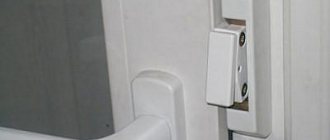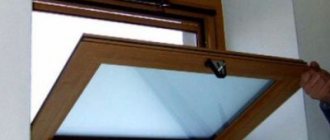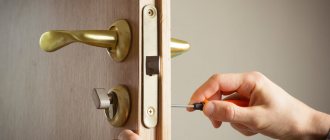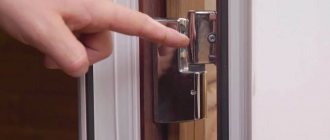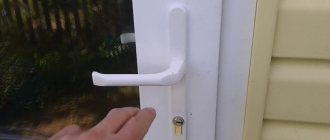The most common problem that owners of balconies face is that the plastic door does not close. There may be many reasons for this, but it’s worth starting to eliminate this defect by adjusting the fittings. This is especially true for awnings and door handles. If you adjust the balcony door in a timely manner, it will last a long time, and the room will be warm. Next, we will consider what to do if the plastic balcony door does not close, and what could be the reasons for such a problem.
The sash sags
Depending on the task, the fittings should be adjusted in different areas. To eliminate the problem of a door sagging under its own weight, you first need to pull it up to the level of the hinge located on top. To do this, you need to open the door. After an adjusting key of the appropriate size has been selected, the screw located on the sash next to the top hinge is tightened.
How to set the vertical
To make the door close more tightly, the screw is turned clockwise. If the upper corner of the sash is at the desired level, it means that the task was completed successfully. Next, you need to ensure that the door is raised. This can be done by adjusting the bottom hinge. The required screw is located in its end part.
But first you need to remove the manufacturer-installed decorative trims from the hinge. The fasteners are tightened enough to ensure free closing of the sash.
The canvas touches the frame
When opening, the top edge of the balcony door may touch the opening. This indicates improper adjustment of the structure when eliminating sagging. It was moved to a greater height than necessary. This type of malfunction can be resolved quite simply - turn the end screw in the bottom hinge once. In some cases, the door does not close completely. As a result, cold air penetrates into the resulting gap. To eliminate drafts, you need to replace the door seal. New rubber profiles are purchased on the construction market.
Use a screwdriver to release the groove from the seal, and then clean it of any remaining glue. Now the groove should be washed with a piece of damp cloth. It must dry thoroughly before installing a new profile. The seal is mounted with the fastening side. The insulation material cannot be stretched. It should be smoothed out carefully. Typically, a special tube with a curved end is chosen for this purpose. The edges of the seal are firmly glued.
Restoring closure tightness
When a plastic balcony door does not close tightly and allows drafts to pass through, adjusting the eccentrics will help. These locking mechanisms (trunnions) are located at the end of the blade on the handle side. And to install them in the desired position you will need either pliers or a special wrench.
The eccentrics have 3 positions:
- standard;
- weak pressure for summer;
- a strong degree of pressing for the winter.
If the third position does not help, the hinges will need to be adjusted. They need to be pulled a little towards the sash. But sometimes the balcony door lock becomes to blame for poor closing tightness. Or rather, his pen. There is play in its movement and it cannot ensure latching.
It is likely that the fastening has become loose due to frequent turning. To get to it, you need to move the decorative cap 90 degrees. Then use a Phillips screwdriver to tighten the screws until they stop. But the lining, in addition to decorative functions, also serves as a locking device. If there is a crack in the cap, you will have to completely replace the pen.
Repair of a plastic door handle Source charmstore.com.ua
And the most serious problem with loss of closure tightness is the rubber seal that has expired. To replace it you will need a simple screwdriver. Using a sharp end, pry the edge of the gasket in any convenient place and mercilessly tear it out of the grooves.
After this, the remnants of the old glue are cleaned off. The groove is washed well with a damp cloth and dried thoroughly. A new seal, pre-treated with a special silicone compound, is carefully placed into the prepared groove. However, it cannot be pulled out. You can only smooth it out. The ends of the rubber gasket are additionally coated with glue to securely fasten it in place.
Sticking in the middle
When the sash sags, we resort to vertical adjustment, and when it jams in the middle due to climatic conditions, we resort to horizontal adjustment.
- Open the sash wide.
- There is a hole at the end, near the inside of the hinges.
- If the mechanism elements are closed with plugs, remove them.
- Insert a hexagon into the hole near the bottom hinge.
- Start clockwise rotation similar to vertical adjustment.
- This will pull the door towards the hinge.
- Check after each rotation.
- If the problem persists and the sash still jams, do the same with the top hinge.
- Once successful, return the plugs to their place.
Design Features
The balcony block is made either as a separate structure or combined with a window. An independent structure is installed in small rooms. Such models can be fully glazed with transparent double-glazed windows or half-glazed.
Combined structures are a single block of windows and doors. Refers to the most popular options in apartments. Such structures consist of one or more double-glazed windows. If the door is equipped with a horizontal impost, the transparent glazing is made flush with the window.
Elimination of defects
Manufacturers make plastic doors with the expectation of long-term service, but many factors interfere with their operation - climate influences, owner inattention, frequent use.
Poor care also affects the properties of the material. The balcony sash should close tightly, preventing the cold from outside from penetrating into the room.
Methods for eliminating defects and malfunctions:
- Adjusting loose mechanisms - hinges, checking the lock and the position of the door leaf. When moving, it should not touch the bottom or top of the opening.
- Timely replacement of the seal is carried out in full - it is impossible to remove the damaged piece by cutting it off from the cord. It is necessary to remove everything and install a new one around the circumference.
- Check the external condition of the sash, including the reverse side.
- After the technician installs a new double-glazed window, carefully check the condition of the mechanisms and evaluate the external characteristics of the object; there should be no design defects.
It is important to understand why over time the door stops working normally - any mechanism wears out, but most types of damage can be fixed by yourself.
Tools needed to fix the problem
When a plastic balcony door does not close tightly, the reason is a malfunction of the leaf itself or its components. Most breakdowns can be repaired at home, using a regular set of tools.
What you will need:
- pliers;
- hex keys - set;
- building level;
- Phillips screwdriver.
Perhaps a new handle and other pieces of hardware should be prepared in advance.
No complicated tool needed
The seal is worn out
This problem may arise after 5 years of regular use of the door, but if preventive maintenance is not carried out, this time can be significantly reduced. The first signal indicating a loose door fit is drafts around the perimeter of the structure. Since the seal cannot be repaired, you need to remove the old one and go to a specialized store to purchase the same one.
You shouldn’t skimp on the seal, but buy a high-quality one from a German or Russian manufacturer, but under no circumstances a Chinese one.
Tips for use
Small defects (small cracks, damage) that appear on a metal-plastic profile during long-term use can be eliminated if you use special means: Cosmetic phone, liquid plastic, wax pencil for laminated surfaces. Larger cracks in the PVC profile, damaged double-glazed windows - such deformations are corrected by specialists.
You can avoid serious problems in the operation of the door if you regularly perform maintenance: clean and lubricate the seal, adjust the fittings, monitor sagging and movement of the sash. Any movement of the door will eventually lead to difficulties when closing, which means that periodic adjustment will save you from serious problems in the future.
Diagnostics and prevention of faults
If the plastic door to the balcony does not close well from the bottom or top, inspect and prevent the fittings.
Factors causing malfunctions of a balcony door:
- profile deformation occurs under the influence of high and low temperatures;
- lack of preventive examination and adjustments;
- glass unit is damaged;
- the seal is worn out;
- the fittings are broken;
- the door sagged.
Preventive measures are carried out 1-2 times a year. During inspection, pay attention to mechanical damage. If necessary, worn-out fittings are replaced with new ones.
During prevention, perform the following actions:
- the elements must support the weight of the door without distortion;
- to prevent the door leaf from sagging, a microlift is used for double-glazed windows;
- carry out seasonal adjustment of the trunnions;
- inspect the hinges: whether the fasteners break or the mechanism fails.
Most often, the hinges and handle are damaged by small children who like to “hang” or ride on the door. If the fittings are damaged, replace the parts. When the door handle does not close well, it is necessary to install a new one.
Signs of violations
You can identify the problem by a number of external signs: you need to open and close the door several times, turning the handle and listening to the sound of the lock.
Next, inspect the sash completely from the inside, then from the outside:
- If the lower end of the door touches the threshold when moving and you have to lift it up to close it, it may have sagged. The problem is typical for wooden or metal-plastic structures, but a heavy glass unit can also sag.
- It clings to the frame with the middle part - the door leaf has moved horizontally / has become deformed.
- It does not close properly even after turning the handle, you cannot hear the characteristic click of the lock, or a gap is visible between it and the sash - the clamping mechanism is broken.
Inspect the rubber insulation, perhaps they have become deformed or come off in some places.
The handle may jam when turning, preventing normal closing. If the handle or the lock itself is broken, only replacing the door will solve the problem.
The source of the problem is often revealed by careful inspection.
